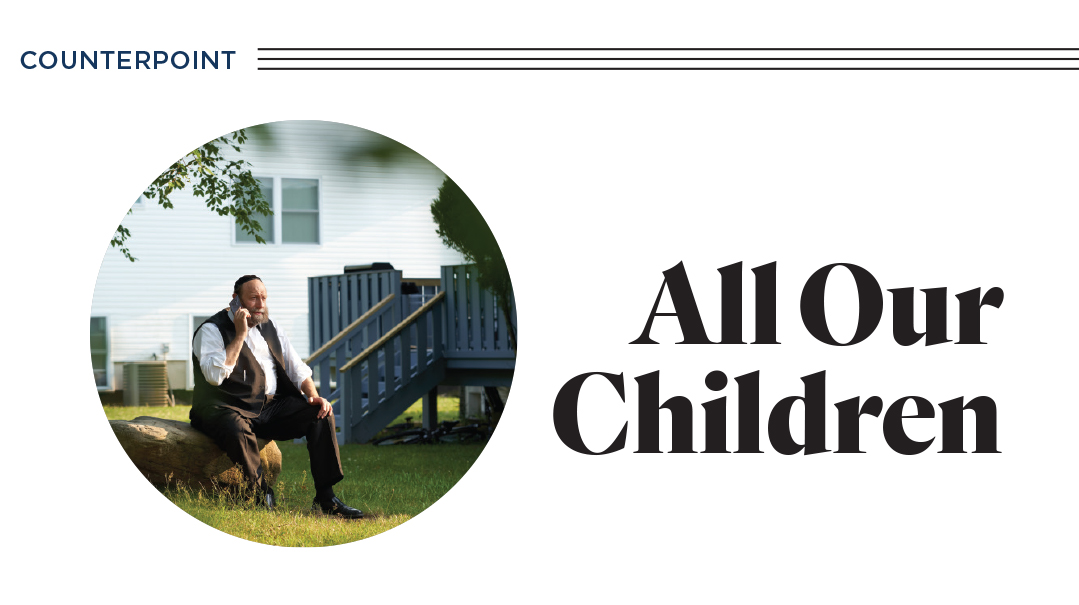Yiddishe Gelt: Issue 881 — the conversation continues

Our Succos supplement Yiddishe Gelt, about the price of frum life today, drew significant and spirited feedback. Here is a sampling

Not in the Yom Tov Spirit
› Esti Becker
I was greatly disappointed with the Succos supplement Yiddishe Gelt. While our finances and spending habits are important topics, it certainly was not in the spirit of the Yom Tov.
Everything has a time and place, and this was definitely not the time (for me) for such a supplement. One was not even able to read it during Yom Tov, as money conversations are considered uvda d’chol. Additionally, reading about such a topic brings most people stress and does not enhance simchas Yom Tov.
I’m surprised that the rabbinic board allowed the supplement to be published. I look forward to being inspired by the special Yom Tov supplements that you publish; this supplement fell short.
A Comprehensive Feel
› David Z. Solomon, Woodmere, NY
Thank you for everything you have done to provide our community with serious articles that provoke and stimulate our brains and our hearts and having the courage to raise difficult issues that we as a community need to confront.
Your special supplement for Succos 5782, Yiddishe Gelt: An Honest Conversation about the Cost of Frum Life, further raised the bar, forcing us to confront one of the most challenging topics in our community.
I personally asked my two teenaged children to read the supplement, and it made a huge impact on them. The collection of articles and visuals immediately gave them a much deeper and comprehensive feel for and sensitivity to the true economic costs of frum life (“Dad, I didn’t know tefillin cost so much”).
I have no doubt that your raising such a fundamental topic, in such a prolific manner, will force us all to think more about this topic, prepare our children in a more comprehensive fashion, perhaps formulate some creative solutions, and hopefully help us all to focus more on the things in our lives that truly matter.
May Hashem bless you in abundance for having the strength to tackle one of the most important topics impacting our community.
Sanity Comes First
› A wife who’s learning to juggle
Although I enjoyed the entire Succos edition, I found the Yiddishe Gelt supplement very intriguing and practical.
My husband and I developed a bit of a unique mentality when it comes to dealing with financial difficulty. My husband has severe anxiety, OCD, and ASD, so we are both in therapy to try and lead a happy life regardless of his limitations. Since the cost of therapy is astronomical (over $15,000 a year plus psychiatrists for him too), and my husband is still learning and I teach, our income isn’t enough to cover those costs in addition to all other expenses.
Adding an income isn’t an option since my husband isn’t capable of holding down a job right now, and I need the stability and hours of my current job to continue holding down the fort at home. Switching to an agency that accepts our insurance isn’t practical right now since we both established strong relationships with our therapists, and it would be too unsettling to switch. Our parents are not able to help out financially in any steady way right now. This is our situation.
I was brought up to be careful and look ahead with finances, so we didn’t buy chicken for five months, and my kids didn’t go to day camp this summer. My self-care right now is a walk at night or a long shower as opposed to weekly mani-pedis or buying expensive sunglasses (something which I hope to be able to do one day). We used up any savings we did have so as not to get into credit card debt.
That was our approach, until recently, when my husband came up with the concept of “sanity comes first” — meaning that an extra session of therapy, buying supper once in a while, or something new for me for Yom Tov takes precedence. He says that our focus right now is on building a functioning home for ourselves and our children, even if it means buying something not in our budget right now.
So we figured out a balance. We pinch and save for the most part, yet splurge when we feel it’s necessary for the journey we didn’t choose but are trying to accept with grace.
I didn’t get a new coat or shoes in two years, but will take an expensive course I feel will help us right now. I buy weekday clothes in Target for my kids instead of the Jewish stores like I used to but will go out for supper with my husband when we feel it will help our relationship. We skip the expensive vacations our friends go on, but we never skip therapy. Ever. (We wouldn’t be able to do this without our extremely caring and understanding therapists who accept headchecks when necessary...)
I hope that having a more open mindset — taking our emotional, mental, physical, and financial well-being into account all at once — will be right for us now.
May we all have the knowledge and abilities to make the right decisions and the right times.
Better Late than Never
› C.K.
I am of the 50-somethings who contacted Naftali Horowitz about the issue he mentioned in his article: We have almost no savings for retirement — and I am terrified.
Mr. Horowitz graciously provided his support and advice and set us on the path to starting scraping together some money for investing, which will hopefully have some time to grow before we retire. Along the way, I found that we had believed many of the common myths that prevent others from investing: that you need a large amount of money to invest, that you need to hire a broker, that you should be worried about losing all your money if you put it somewhere that is not FDIC insured… and that you can’t afford to invest now for later.
To frum families of all ages, I would like to share the wisdom that I learned from Mr. Horowitz and other sources:
- Late is better than never — but really, the earlier the better. Because of compound interest, your returns increase exponentially the earlier you invest. A startling chart indicates that someone investing X amount per year for 10 years starting at age 20, even if they stop contributing at age 30, will end up with a larger amount at age 65 than someone who invests the same amount per year for 30 years between ages 30 and 60. The advantage of time makes even small, regular contributions powerful.
- To balance risk and rewards, choose an indexed fund that is linked to the status of the stock market as a whole (e.g., indexed to the S&P 500). Individual stocks may rise and fall, but the stock market on the whole has historically risen over any given 20-year period.
- To further mitigate risk as you get closer to retirement age, choose a life cycle fund, with a target date close to your anticipated retirement. This type of fund will shift an increasing percentage of investments to safer bond funds as your retirement date nears.
- Set up a Roth IRA, which allows you to invest a limited amount per year and then withdraw the results tax free after retirement.
- Take advantage of your employer’s 401K plan (403b for non-profits). This allows you to invest a percentage of your income pre-tax, and some employers will even match your donation up to a certain percent. (Free money — don’t leave it on the table!)
- Established online companies like Fidelity.com and Vanguard.com are excellent resources for setting up investments, with the option of automatic monthly contributions directly from your checking account. Their free customer service, which is available through evening hours, is patient and friendly (even if you are totally clueless), and will take you through the steps you need.
Relying on Social Security? Make sure you take some factors into account:
- Currently, Social Security benefits at full retirement age max out at about $3,200 a month — and that is for someone who has earned $143,000 per year for 35 years of his career. For the rest of us, monthly benefits are calculated based on the worker’s 35 highest-earning years, and payout may be as low as several hundred dollars per month.
- The salary used to determine SS benefits is the taxable income. So any legitimate reduction in taxable income, including parsonage and QTR (tuition reduction), also reduces future Social Security benefits.
- The future of Social Security is not clear, but it is widely accepted that the current system (in which a shrinking pool of workers pays the benefits of a growing pool of retirees) cannot remain viable for long. Workers age 40 and under should consider the possibility that their expected benefits may be greatly reduced from current levels.
As we struggled to create a better-late-than-never plan, I decided that at least the next generation should start off with the right habits. I encouraged my teenagers to invest a portion of their earnings and gift money; they didn’t need much convincing when they saw the charts demonstrating the effects of early investing.
Most of your readers are probably thinking, “But I can’t afford to invest right now.” And the truth is that for most of us, the “right time” for investing for the future will never come. But consider that we all somehow find the funds for necessities; we are used to prioritizing our minimal needs like food, shelter, and our children’s chinuch. Making hishtadlus for our own support when we can no longer work ranks right up there with the basics.
(Originally featured in Mishpacha, Issue 881)
Oops! We could not locate your form.





